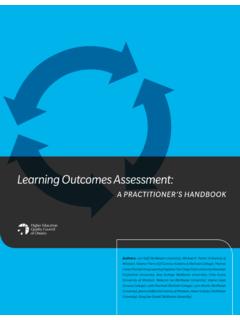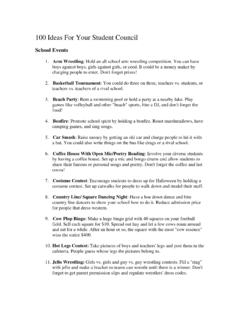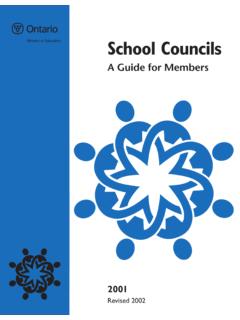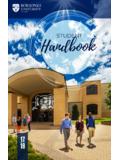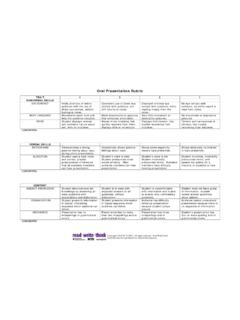Transcription of Student Course Evaluations - HEQCO
1 Student Course Evaluations : Research, Models and Trends by Pamela Gravestock and Emily Gregor-Greenleaf, University of Toronto Published by: The Higher Education Quality Council of Ontario 1 Yonge Street Suite 2402. Toronto, ON Canada M5E 1E5. Phone: (416) 212-3893. Fax: (416) 212-3899. Web: E-mail: Cite this publication in the following format: Gravestock, P. & Gregor-Greenleaf, E. (2008). Student Course Evaluations : Research, Models and Trends. Toronto: Higher Education Quality Council of Ontario. An agency of the Government of Ontario The opinions expressed in this research document are those of the authors and do not necessarily represent the views or official polices of the Higher Education Quality Council of Ontario or other agencies or organizations that may have provided support, financial or otherwise, for this project.
2 Queens Printer for Ontario, 2008. Table of Contents 1. Introduction A. Methodology B. Limitations 2. Context A. Evaluating teaching in higher education B. The vocabulary of Student Course Evaluations C. Faculty, administrator and Student perceptions of Course Evaluations i. Faculty perceptions ii. Administrator perceptions iii. Student perceptions D. Common characteristics of Course Evaluations i. Common measures of teaching effectiveness ii. Collecting and interpreting qualitative feedback iii. Collecting and interpreting formative feedback E.
3 Common uses for Course evaluation data 3. Current Policy and Practice in North America A. Introduction B. Course evaluation policies i. Prevalence and location of policies ii. Focus and scope of policies C. Design and approval of evaluation instruments i. Development and approval of evaluation instruments ii. Questionnaire format and content iii. Review of evaluation instruments D. Implementation processes i. Method of delivery ii. Implementation guidelines or policies E. Analysis of results F. Access to results i.
4 Who has access? To what? ii. Management of written comments Student Course Evaluations : Research, Models and Trends 1. iii. Publication of results G. Interpretation and use of results i. Summative and formative purposes ii. Information supplied with evaluation results iii. Use of written comments iv. Tenure, promotion and merit v. Teaching awards vi. Other evidence of teaching effectiveness H. Relationship of Course Evaluations to accountability measures 4. Reliability, Validity and Interpretation of Course evaluation Data A.
5 Introduction to reliability and validity B. students as evaluators C. External Validity: Creating the instrument i. Defining effective teaching ii. Developing evaluation instruments D. External Validity: Reporting and interpreting evaluation results i. Reporting of evaluation results ii. Challenges to interpretation and use for summative purposes E. Internal Validity: The influence of variables on evaluation results i. Overview of studied variables ii. Validity testing 5. Implementing Effective evaluation Measures: Recommendations from the Research A.
6 Introduction B. Ensuring Validity C. Ensuring Utility i. For students ii. For instructors iii. For administrators iv. For institutions 6. Emerging Trends, Existing Gaps and Recommendations for Further Research A. Emerging trends i. Online evaluation tools Student Course Evaluations : Research, Models and Trends 2. ii. Connecting evaluation data to accountability measures and competency-based learning outcomes iii. Increasing use of Evaluations for formative purposes iv. Contextualization of evaluation data for summative evaluation of teaching B.
7 Existing gaps and suggestions for further research i. Defining teaching vocabulary and expectations ii. Understanding evaluation users iii. Educating evaluation users iv. Evaluating graduate Student teaching assistants and instructors 7. Concluding Remarks Student Course Evaluations : Research, Models and Trends 3. Appendices A. Measures of Teaching Effectiveness 1. Student evaluation of Educational Quality (SEEQ) Instrument 2. Individual Development & Educational Assessment (IDEA) Student Ratings of Instruction 3.
8 Teaching Behaviours Inventory B. Sample Institutional evaluation Instruments 1. Dalhousie University 2. Harvard University 3. Humber College Institute of Technology and Advanced Learning 4. McGill University 5. Queen's University 6. Ryerson University 7. Seneca College Institute of Technology and Advanced Learning 8. University of Alberta 9. University of Minnesota 10. University of Ontario Institute of Technology C. Institutional Documents relating to Course Evaluations 1. Pool of Questions for Course Evaluations , McGill University 2.
9 Pool of Questions for Course Evaluations , University of Michigan 3. Sample Ratings Data Reports, University of Alberta 4. evaluation Review FAQ, University of Minnesota 5. Institutional & Organizational Documents D. Other Policy Documents relating to Student evaluation of Teaching 1. CAUT Model Clause on the evaluation of Teaching Performance 2. CAUT Policy on the Use of Anonymous Student Questionnaires in the evaluation of Teaching 3. AAUP Statement E. Summaries of Research on Potentially Biasing Variables F.
10 Guidelines for Good evaluation Practice a. Cashin (1990). b. Franklin (2001). c. Theall (2002) and Theall & Franklin (2001). Student Course Evaluations : Research, Models and Trends 4. d. Zabaleta (2007). G. Recommendations for Future Research H. Annotated Bibliography I. Works Cited Student Course Evaluations : Research, Models and Trends 5. Contributors Pamela Gravestock is the associate director of the Office of Teaching Advancement at the University of Toronto where she works with faculty on a range of teaching and learning issues and initiatives.



